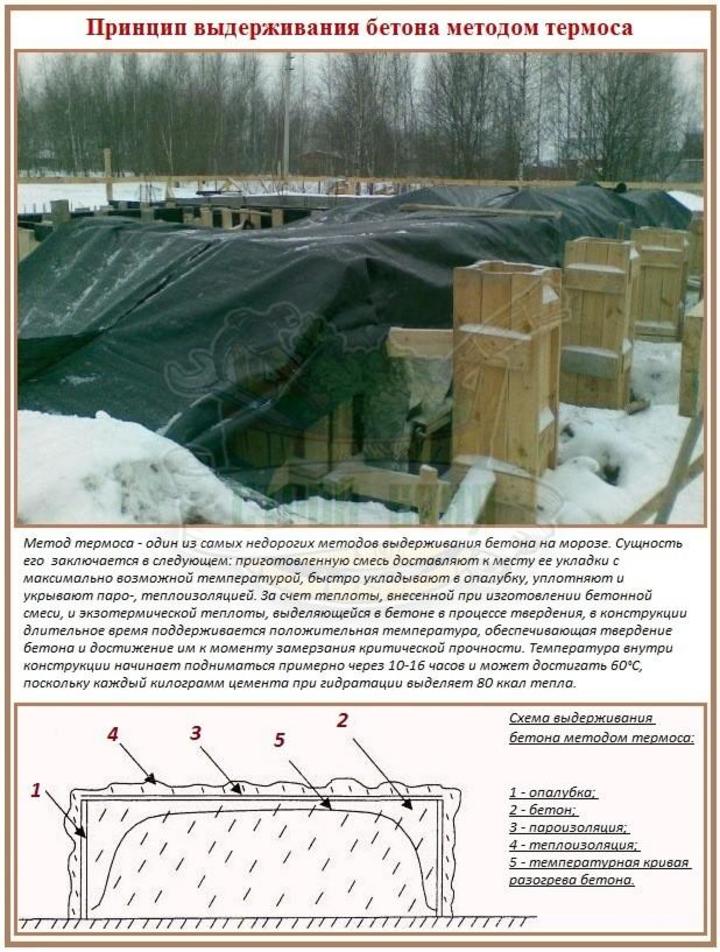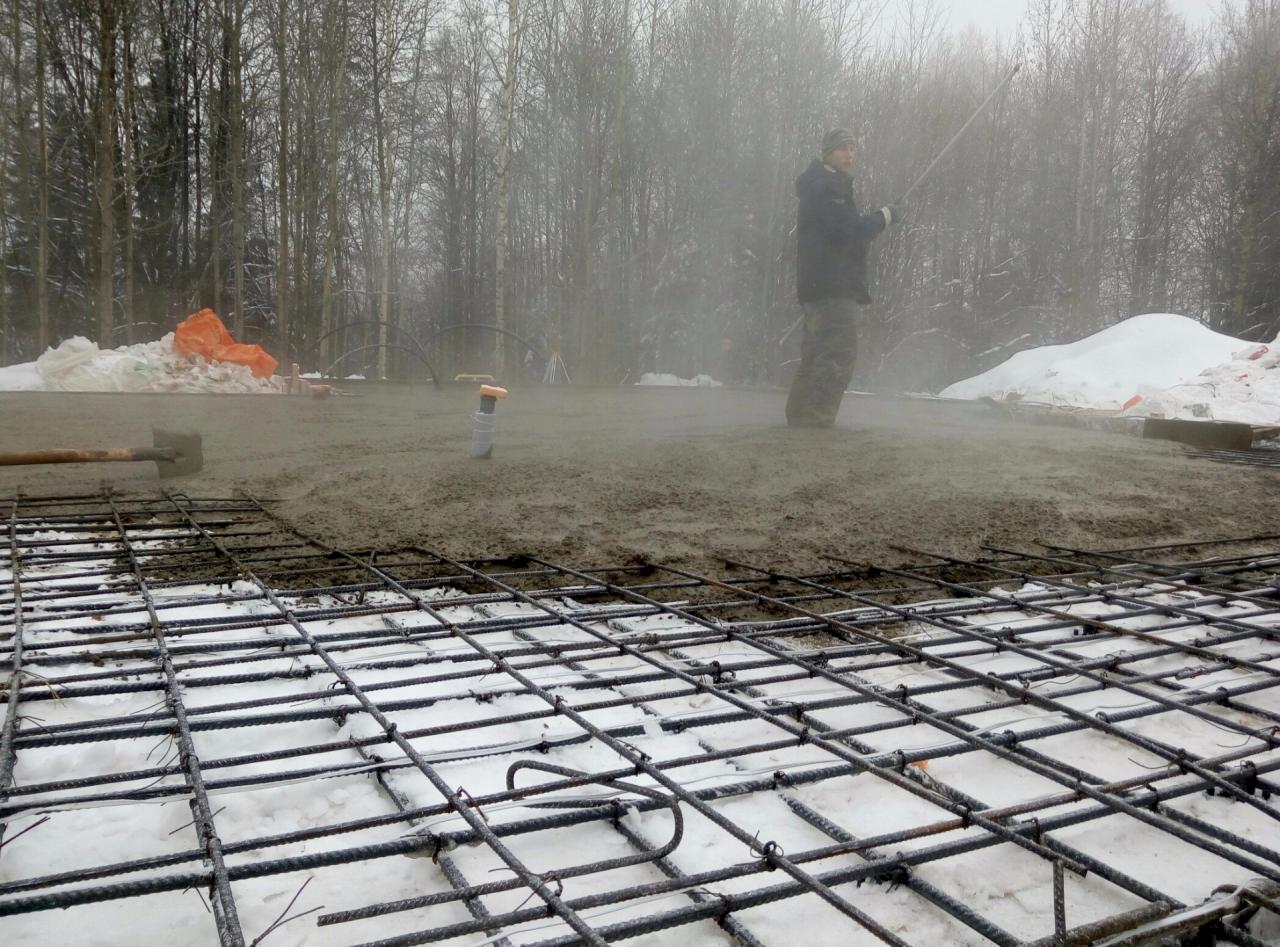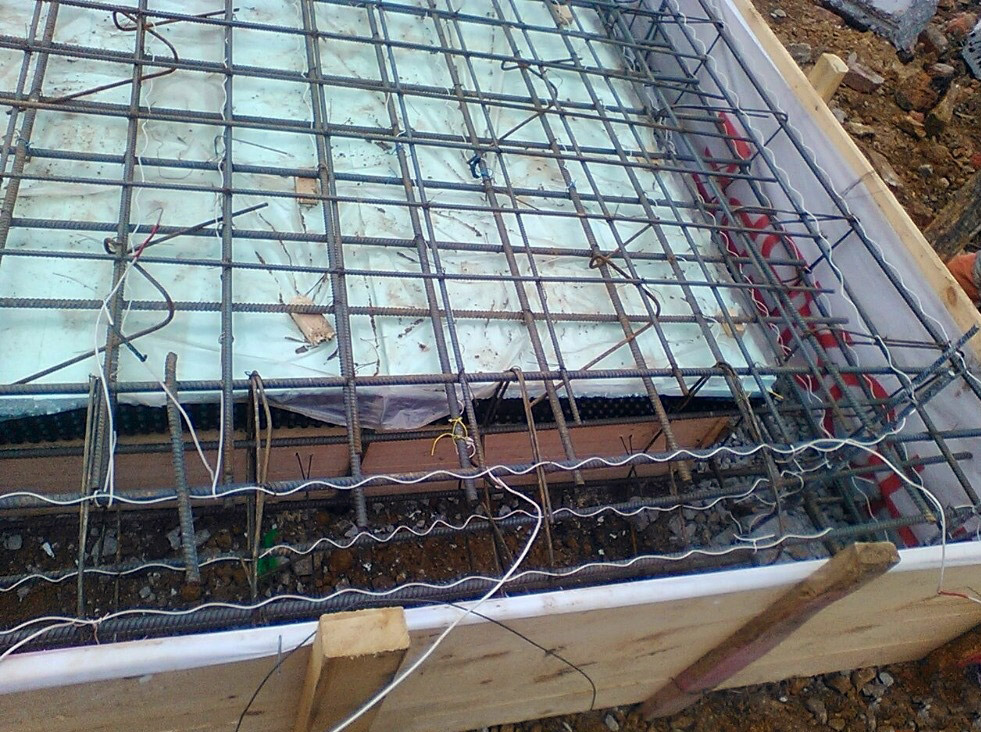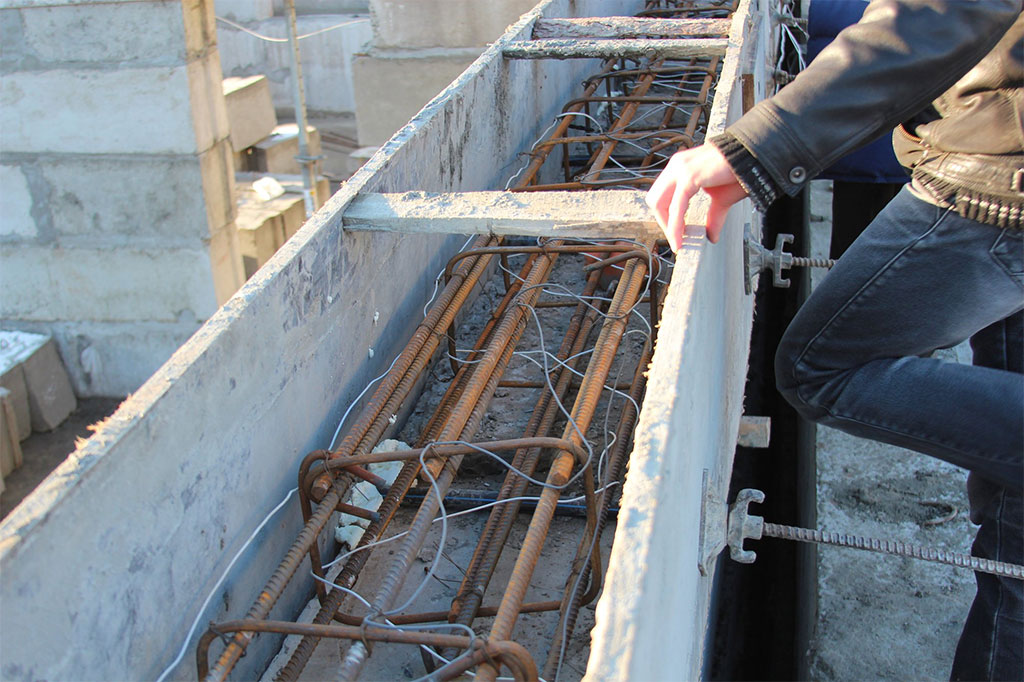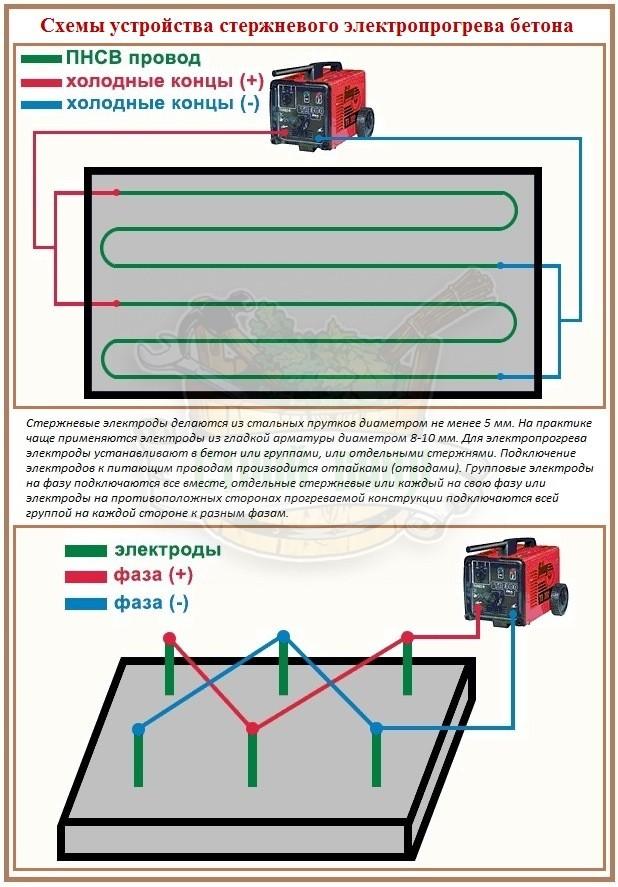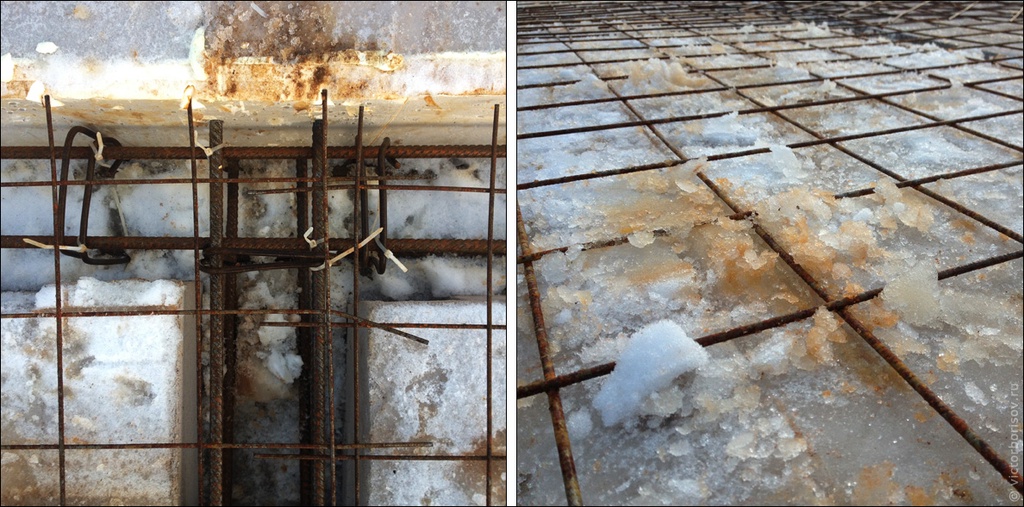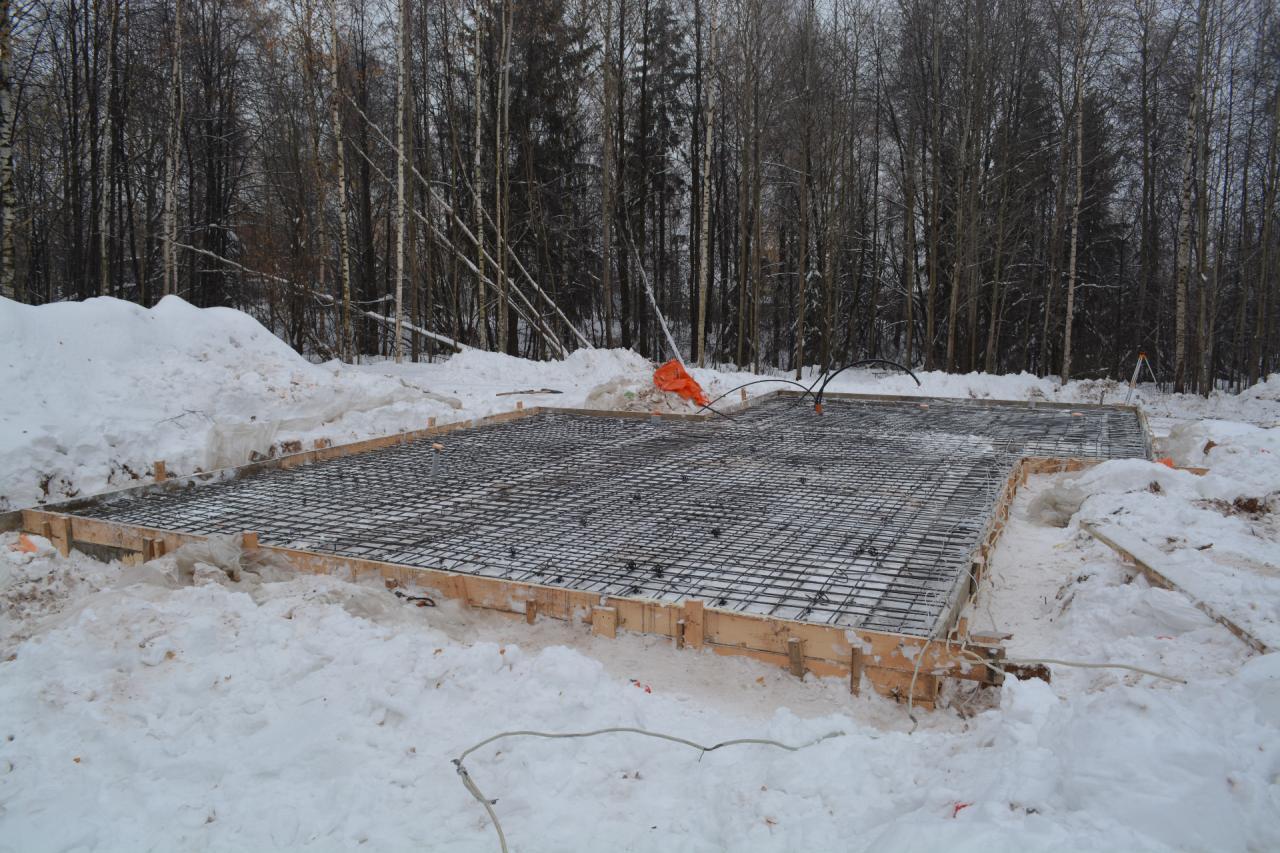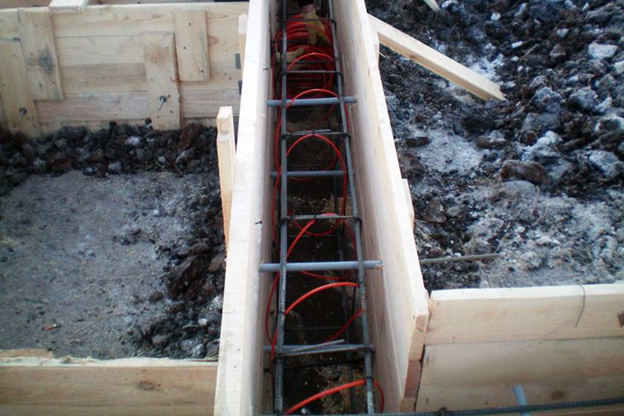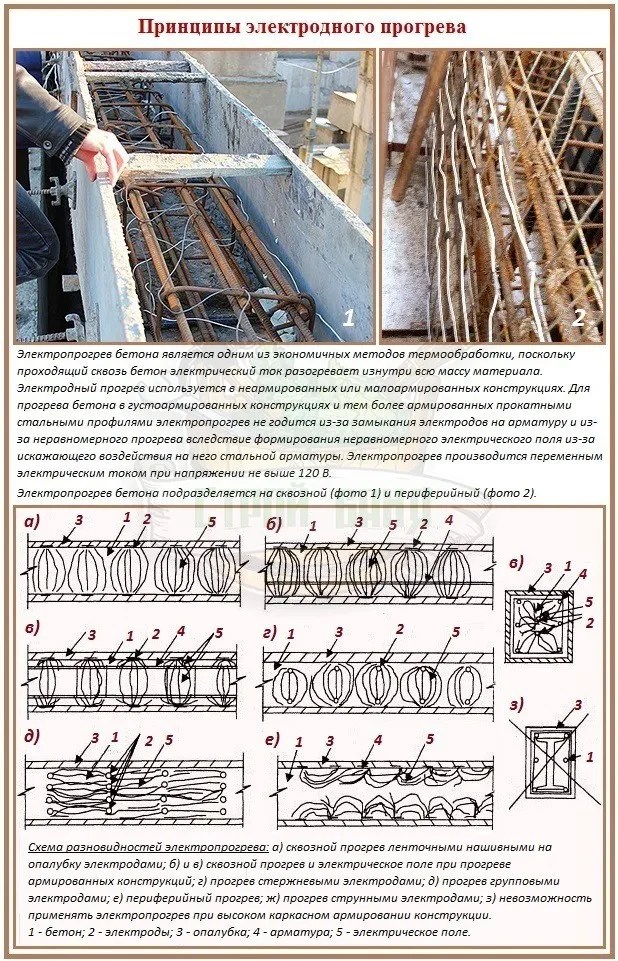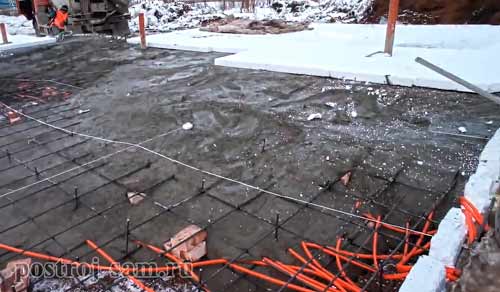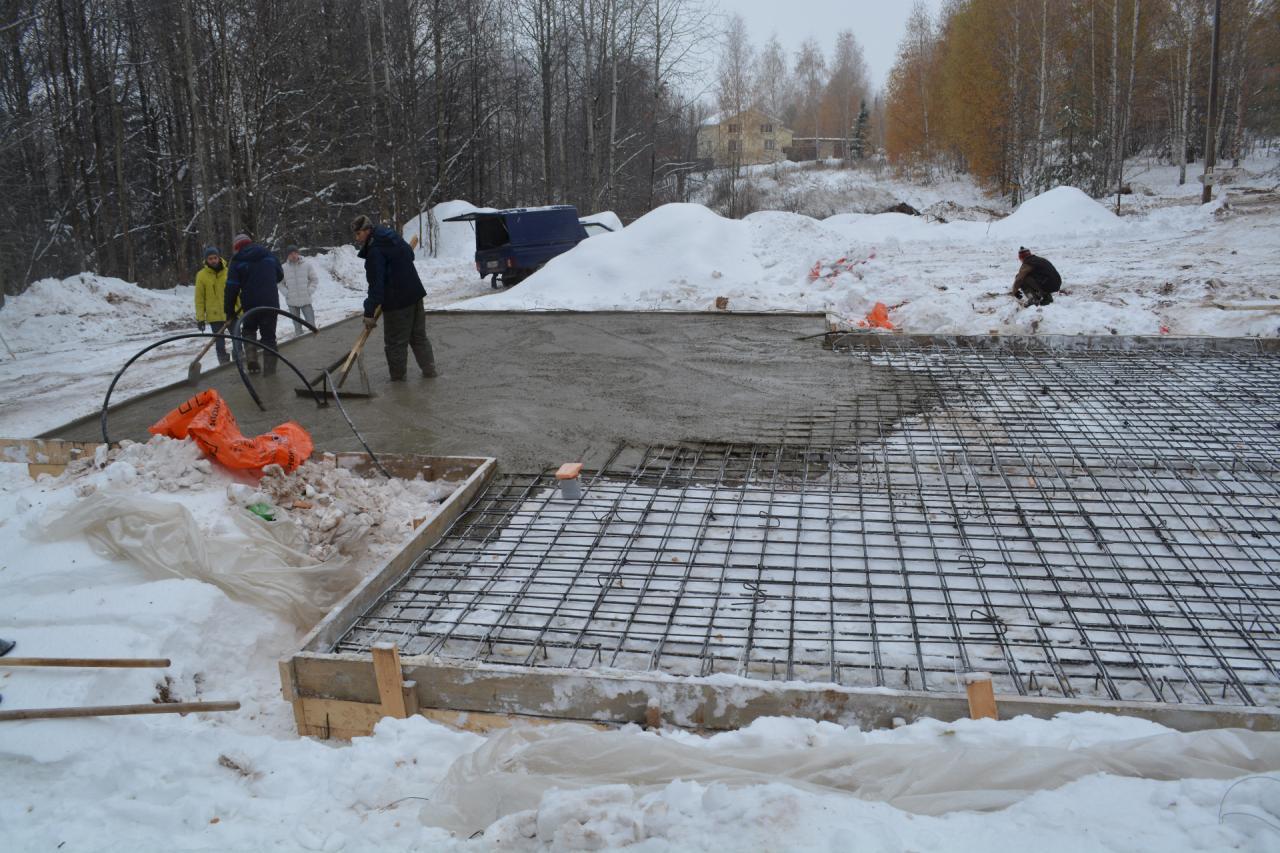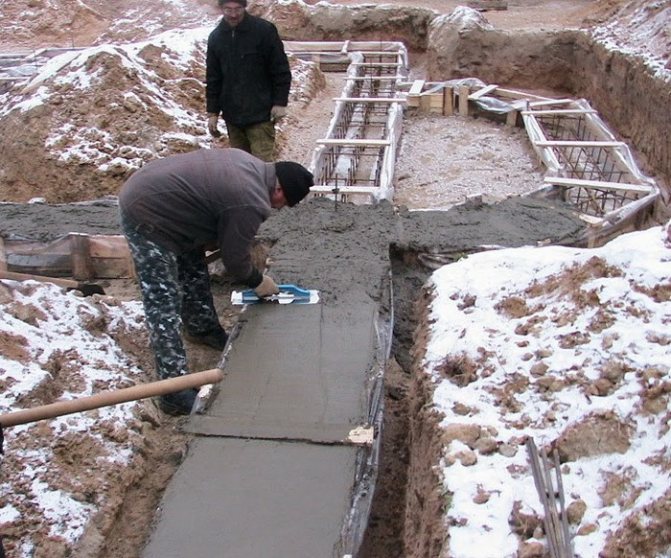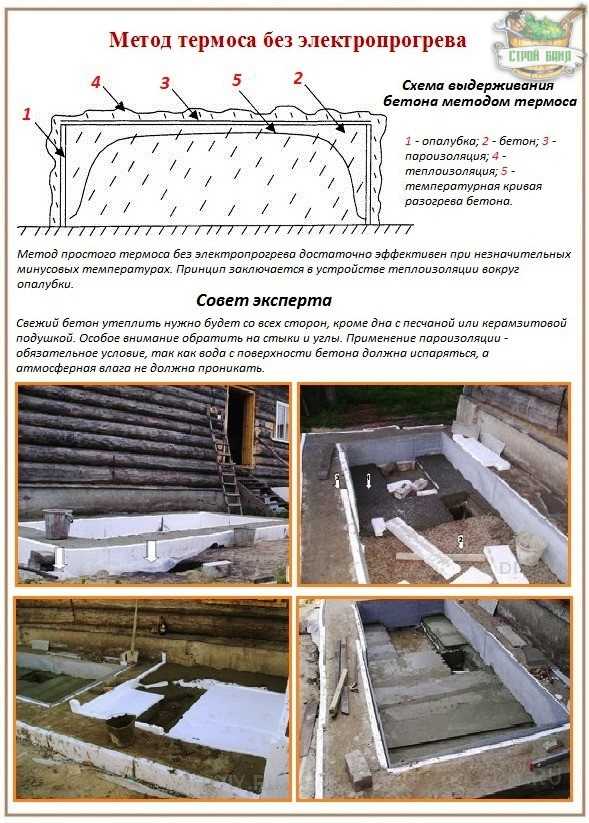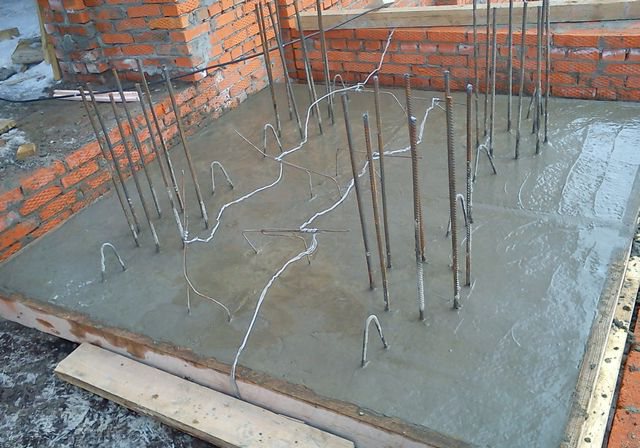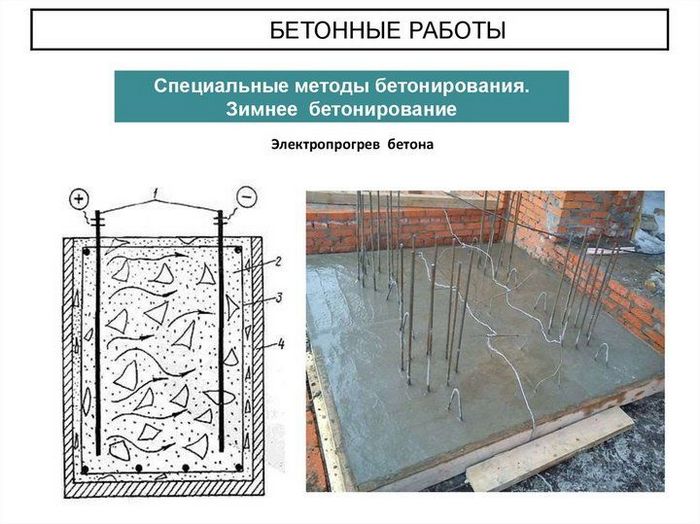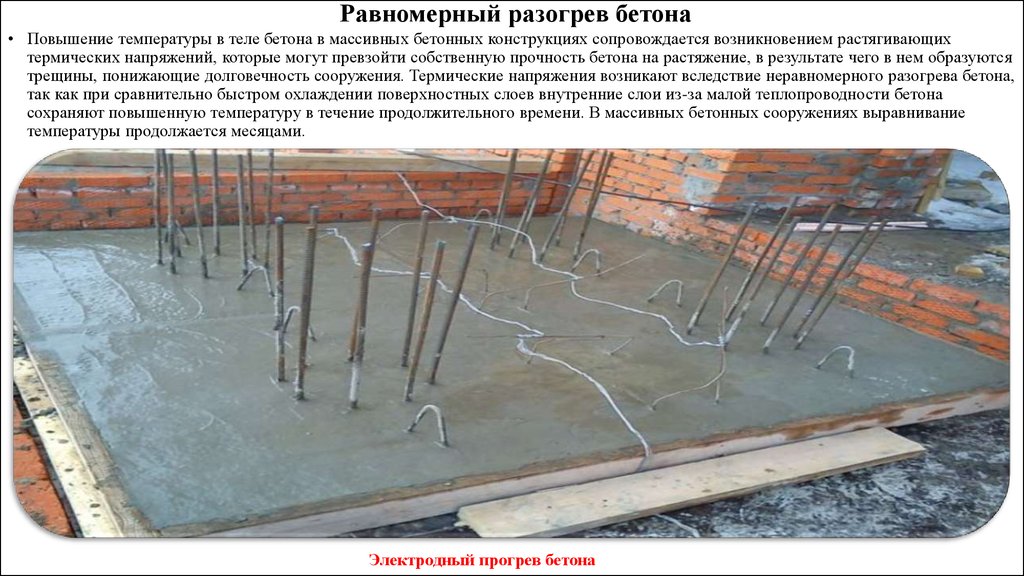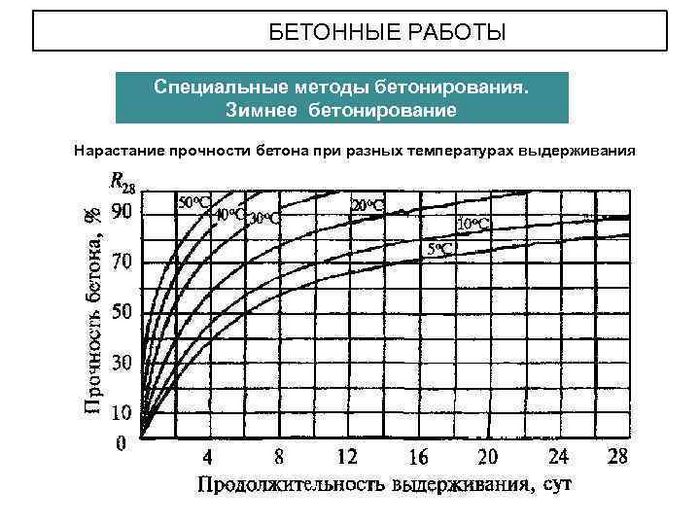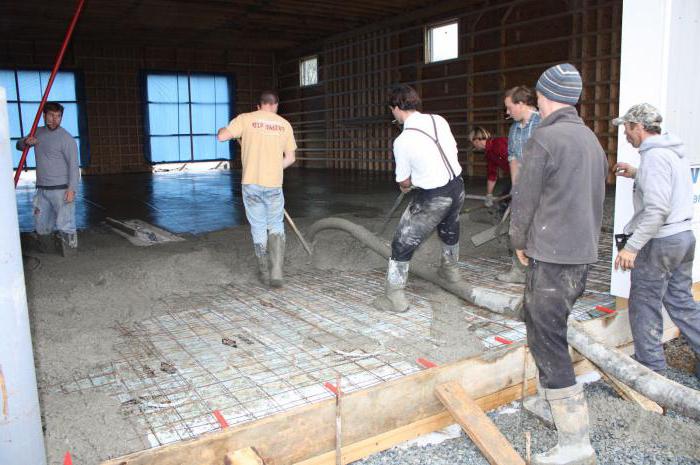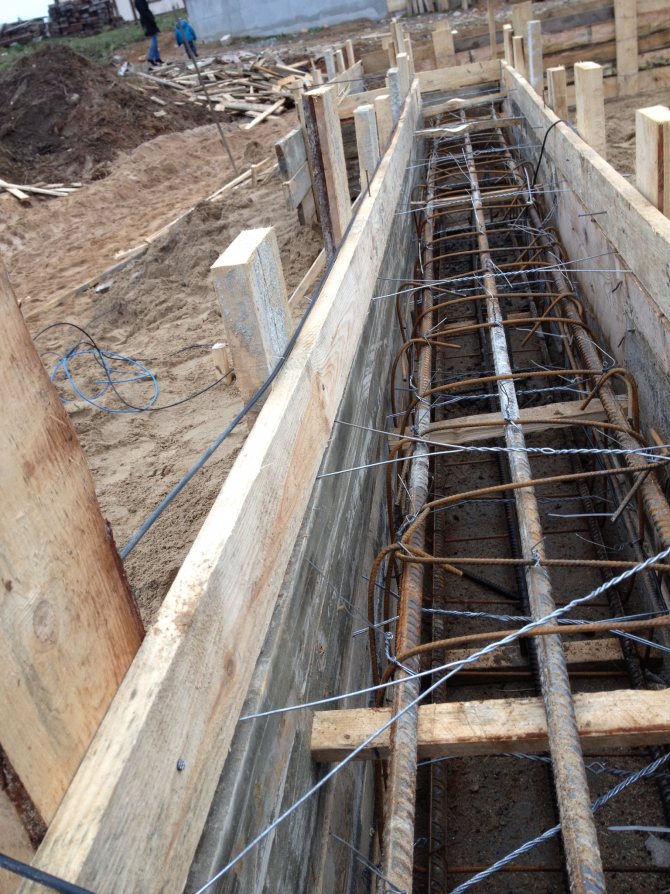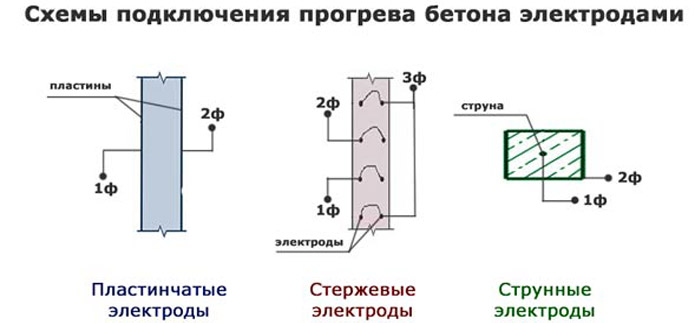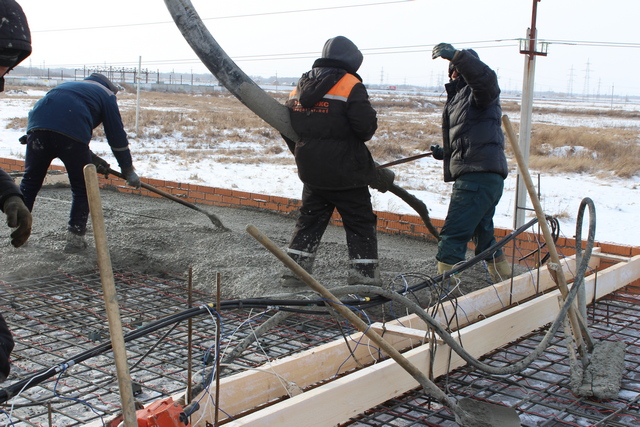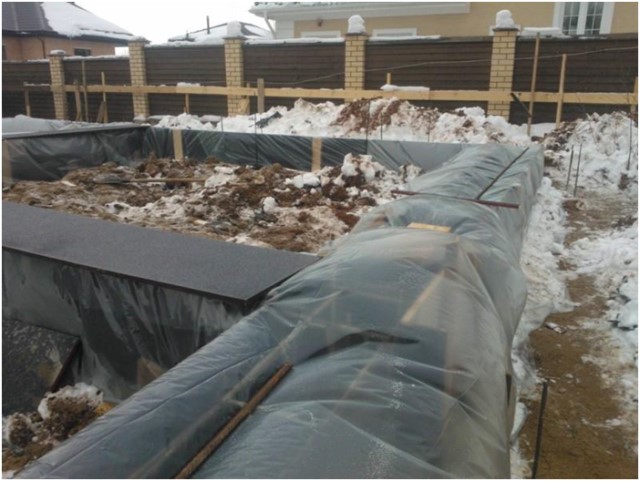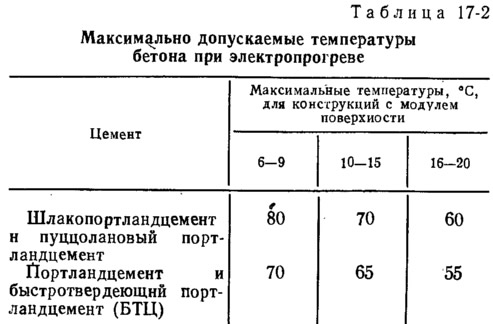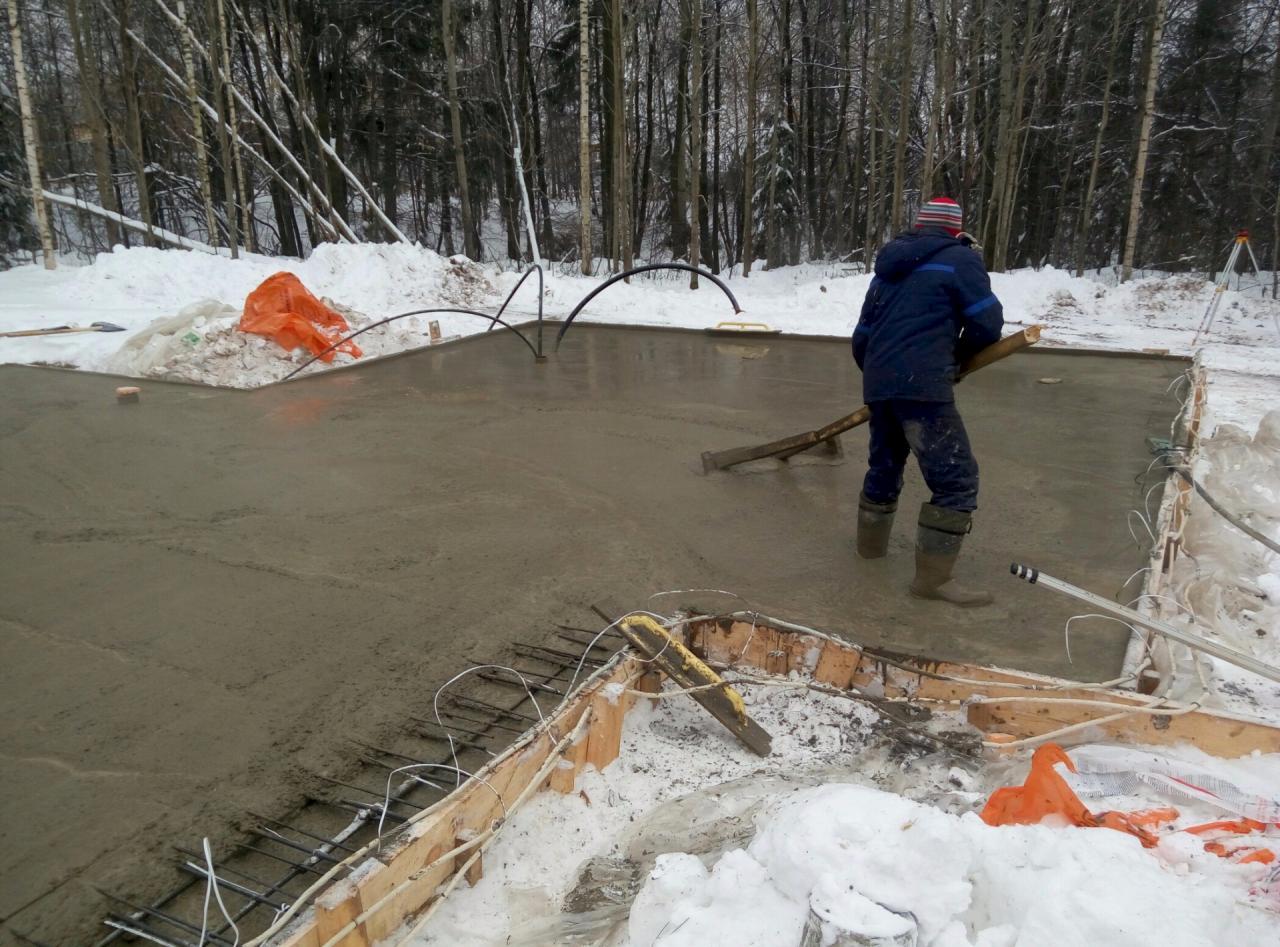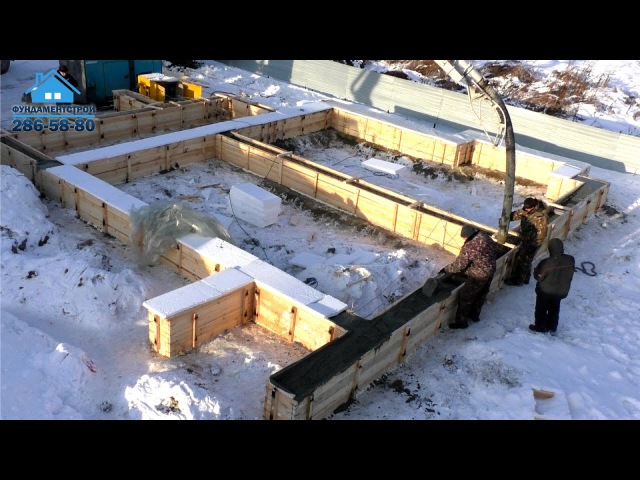The composition of the mixture
When we hear or say "concrete", we rarely think about what this material is. And, of course, we do not at all think about why all the instructions for the care of freshly poured concrete structures state that it is necessary to water the concrete. If we try to bring all the definitions found in the special literature into one, then we get a definition that explains that concrete is an artificial stone material that forms a rationally selected, thoroughly mixed and compacted, hardened mixture.
Concrete floor scheme.
The composition of the concrete mixture includes: a binder (cement), coarse and fine aggregates (gravel or crushed stone and sand, respectively), water and special additives (if needed). The density of concrete in the hardened state should be 2200-2500 kg / m³.
Water and binder are the active components of the concrete mixture, which envelop the grains of the passive element of the concrete mixture - the aggregate - in a thin film. Over time, the water softening the binder evaporates, the binder hardens and binds the enveloped aggregate grains, turning the mixture into a durable monolithic artificial stone - concrete.
Aggregates in a concrete mix occupy 80-85% of the concrete volume. It is clear that what the concrete will be in the future in terms of its physical and mechanical characteristics directly depends on the properties of the aggregate. It is easy to calculate that for the two active components of the concrete mixture - cement and water - 15-20% remains in the volume of the concrete mixture. With the generally accepted ratio of cement to water 2: 1, cement takes 10-13%, and water, respectively, 5-7% of the volume. For most brands of concrete, this figure becomes 190-200 liters per 1 m³ of concrete mixture.
Winter concreting
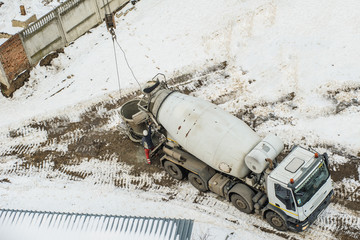
Since a low temperature significantly reduces the rate of hardening, and frost has a detrimental effect on the structure as a whole, it means that the concrete must be warmed up. Moreover, it is necessary to ensure uniform heating. The minimum temperature for pouring concrete must be above + 5C. If the temperature inside the mixture is higher than the temperature outside the mixture, then this can lead to deformation of the structure and the formation of cracks. Concrete is heated until critical strength is achieved. In the absence of data in the design documentation on the value of the critical strength, it must be at least 70% of the design strength. If the requirements for frost resistance and water tightness indicators are established, then the critical strength should be at least 85% of the design.
When pouring concrete into subzero temperatures, different technologies for heating concrete are used. The most commonly used methods are:
- Thermos
- Electric heating
- Steam heating
Thermos method
This method is used for massive structures. It does not require additional heating, but the temperature of the mixture to be laid should be more than + 10C. The essence of this method is that the laid mixture, while cooling, has time to gain critical strength. The chemical reaction of concrete hardening is exothermic, i.e. heat is generated. Therefore, the concrete mix heats up itself. In the absence of heat loss, concrete can heat up to a temperature of more than 70C. If the formwork and open surfaces are protected with a heat-insulating material, thus reducing the heat loss of the hardening concrete, the water will not freeze and the concrete structure will gain strength.
To implement the thermos method, no additional equipment is required, therefore it is economical and simple.
Electric heating of concrete mix

If it is impossible to ensure a set of critical strength by the thermos method, then they resort to electric heating. There are three main ways:
- heating with electrodes
- induction heating
- use of electric heaters
The method of heating with electrodes is as follows, electrodes are introduced into the freshly laid mixture and a current is applied to them. When an electric current flows, the electrodes heat up and heat the concrete. It should be noted that the current must be alternating, because at a constant current, electrolysis of water occurs with the release of gas. This gas shields the surface of the electrodes, the current resistance increases and the heating decreases significantly. If the structure uses iron reinforcement, then it can be used as one of the electrodes
It is important to ensure uniform heating of the concrete, and to control the temperature. It should not exceed 60C
Electricity consumption with this method varies in the range of 80 - 100 kWh per 1 m3 of concrete.
Induction heating is rarely used due to the complexity of the implementation. It is based on the principle of non-contact heating of electrically conductive materials by high-frequency currents. An insulated wire is wrapped around the steel reinforcement and a current is passed through it. As a result, induction appears and the reinforcement is heated.
Energy consumption during induction heating is 120 - 150 kWh per 1 m3 of concrete.
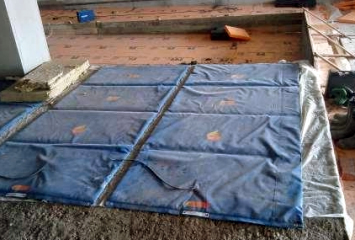
Another way to electrically heat concrete is to use electric heating devices. There are heating mats that are laid out on the concrete surface and connected to the network. You can also build a kind of tent over the concrete and put electric heating devices inside, for example, a heat gun. But in this case, care must be taken to retain moisture in the concrete, to prevent premature drying.
At an ambient temperature of -20C, the electricity consumption, with this method, will be 100 - 120 kWh per 1 m3 of concrete.
Steam heating of concrete
Steam heating of concrete is very effective and is recommended for thin-walled structures. On the inside of the formwork, channels are created through which steam is passed. You can make a double formwork and let the steam pass between its walls. You can also lay pipes inside the concrete, and pass steam through them. Concrete is heated in this way to 50 - 80C. Such temperature and favorable humidity accelerates concrete hardening several times. For example, in two days, with this method, concrete gains the same strength as during a week of hardening under normal conditions.
But this method has a significant drawback. An impressive cost of organizing it is required.
Application of antifreeze additives
The introduction of chemical additives when pouring concrete in winter allows the mixture to be poured without heating. This method is economical and does not require the installation of additional heat-saving structures at a relatively low temperature. The use of additives can be used in addition to heating the hardening material. In both cases, there is a noticeable cost reduction when applied in conjunction with the Thermos method.
For pouring concrete in winter, two types of additives are used: to accelerate solidification and to lower the freezing point. The recommended concentration is from 2% to 10%, the exact figure is selected depending on the air temperature and the mass of dry cement. The addition of chemicals is one of the winter concreting methods; it is appropriate in late autumn and during the first frost.
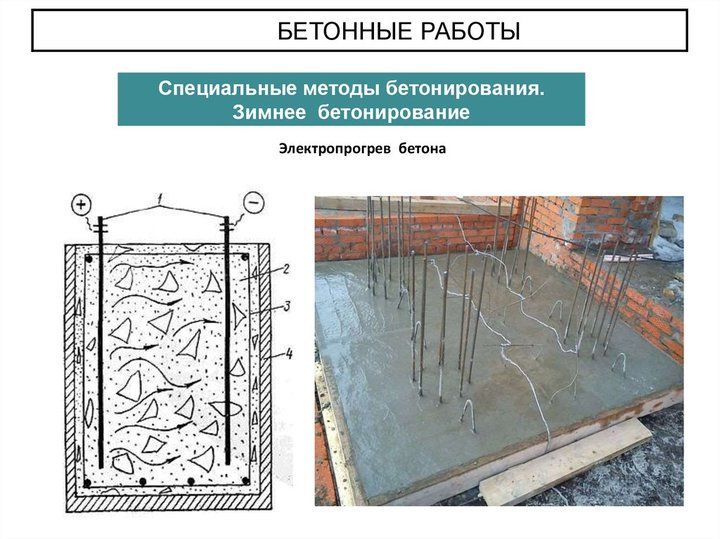
Among the common additives to concrete, the following are especially distinguished:
- Sodium nitrite NaNO2 (nitrous acid salt). Improves solidification strength at temperatures not lower than 18.5 ° C. Plus - anti-corrosion effect, minus - stains remain on the concrete surface.
- Calcium chloride CaCl2. If the appearance of efflorescence on the surface of the hardened material is not critical, this agent will accelerate the setting of concrete. You can work with it up to -20 ° C, the grade of cement powder should increase with the concentration of chloride introduction.
- Potassium carbonate (potash), K2CO3 aka potassium carbonate.The best modifier for concrete in terms of convenience and properties. It does not leave streaks or corrosion on fittings. The only drawback is that this catalyst acts too intensely on the solidification rate. You need to finish the job in 45-50 minutes.
You cannot add "chemistry" to clean concrete! First, it is stirred in water, after which it is combined with a mixture of cement. For uniform solidification, increase the stirring time by 1.5 times. Ordinary salt can improve the setting of concrete mix, but only slightly.
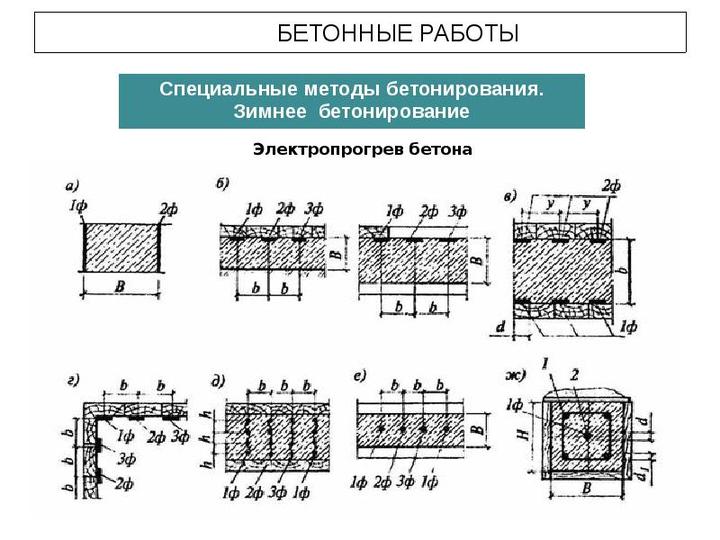
Concrete curing stages
Concrete is a mixture of cement and fillers - sand, gravel, expanded clay - with water. To improve the fluidity of the solution, increase frost resistance and give it special properties during mixing, various additives and plasticizers are also added to concrete.
After preparation, the liquid solution is poured into a form called formwork, after which irreversible processes begin in the concrete:
- Concrete setting. During this stage, the concrete slurry becomes solid due to the interaction of the components of cement and water. However, the bonds between the components are still very fragile, and when exposed to a load, they can collapse, while the re-setting of the solution does not occur.
This phase lasts, depending on the air temperature, from 3 hours to 1 day. The lower the temperature, the longer the concrete cures. At the same time, in the initial stage of setting, it remains liquid without any structural changes. If during this period of time a new portion of concrete is added to the formwork. No destruction of the cement bonds will occur. For a temperature of 20 ° C, the "liquid" stage lasts about 2 hours, at zero temperature it lasts about 6-8 hours.
It is possible to extend the time before setting begins by constantly stirring the concrete, but this will worsen its performance, so this method should not be abused.
- Concrete hardening. This phase lasts quite a long time, due to the gradual hydration of the concrete components, the foundation gains strength over many years. The first 28 days is a mandatory period of concrete curing until it gains strength corresponding to its brand. Hardening occurs rather quickly in the first day, then its speed slows down.
- In the first hours after setting, the hardness of the concrete is still low, and the addition of the next portion of concrete can lead to microcracks due to an increase in the load. After three days of hardening, as a rule, these loads do not have such an effect on the first layers of concrete.
Based on the characteristics of concrete maturation, we can say: you can fill the foundation in parts. In this case, you need to follow some rules:
- With successive mixing of batches of concrete, the time between pouring them into the formwork should not exceed 2 hours in warm weather and 4 hours in the off-season. In this case, no seams are formed, the strength of the foundation does not change.
- If it is necessary to take a long break from work, it should be at least 2-3 days. After a break, the surface of the foundation, onto which a fresh portion of concrete will be poured, must be cleaned of dust, moisture, and also cleaned with a metal brush. The seam will have good adhesion.
- When filling the foundation with parts, all recommendations for reinforcement must be followed.
Ways to reinforce the corner at the foundation
Layer by layer or in blocks? (fill in parts)
Another question that worries developers is how to properly distribute the portions of concrete? Three types of seam arrangements are possible:
- Horizontally;
- Vertically;
- At an angle.
SNiP in this regard gives specific instructions: the seam between the sections of the monolithic foundation should be directed perpendicular to the axis. That is, for columns and piles, only layer-by-layer concrete pouring with the formation of horizontal joints is suitable.
For a strip monolithic foundation, the seams can be located both vertically and horizontally.To maintain the strength of the foundation, high-quality reinforcement is necessary, directed perpendicular to the joints of monolithic blocks. If the seams are made vertically, then the longitudinal reinforcement must necessarily firmly bind the corners of the building. In case of layer-by-layer horizontal filling, the installation of vertical reinforcement is required. In practice, the strip foundation is usually poured in layers, since the installation of additional formwork is required to pour individual vertical blocks.
Pouring concrete at low temperatures
During winter concreting, the following errors often occur:
- the time required for finishing the concrete surface increases;
- increase in the cost of concreting;
- a weak dusty concrete surface is formed;
- cracks are formed.
To avoid the above consequences, it is necessary to adhere to the following recommendations during the preparation and placement of the concrete mixture.
Temperature range of concrete mix
 When pouring concrete in winter, you need to remember about the need to comply with the temperature regime of the concrete mixture:
When pouring concrete in winter, you need to remember about the need to comply with the temperature regime of the concrete mixture:
- freshly prepared concrete mixture should have a temperature not higher than 30 ° C;
- when pouring concrete under conditions of an average daily air temperature from + 5 ° C to - 3 ° C, it must have a temperature: with a concrete grade from M200 and above - at least + 5 ° C; with a smaller grade of concrete - at least + 10 ° C;
- if the air temperature is below - 3 ° C, then safe concreting is possible if the temperature of the concrete mixture is maintained at a level not lower than + 10 ° C for 3 days.
Preparation of concrete in winter
Concrete mix for pouring concrete at low temperatures is prepared taking into account the following:
- use a high content of cement;
- reduce the water-cement ratio;
- granular fillers are preheated to + 35 ° C;
- water is heated to + 70 ° C;
- heated water is pre-mixed with a granular filler and only then cement is added;
- when using a concrete mixer, the ingredients are served in the following order: granular aggregate + the main part of the heated water; do a few turns; fill in the rest of the water. Duration of mixing is at least 1.5-2 minutes (1.5 times more than in accordance with summer norms);
- use antifreeze and air-entraining additives;
- the concrete mixture is heated to a temperature not exceeding + 30 ° C;
- the vibration duration is increased by 1.25 times.
A few more important points:
- preheated concrete mixture and a mixture with anti-freeze additives can be laid on an unheated non-porous base (sand cushion) or old concrete only if, in accordance with the calculations, in the contact zone during the design period of concrete curing, it does not freeze;
- after laying and compaction, the concrete mixture is covered with a polymer film, as well as with heat-insulating materials, which allows you to preserve the heat released during the hydration of cement;
- in order to be sure of the strength of the monolithic foundation, you need to remember: if within 28 days the average daily temperatures can drop below + 5 ° C, it is not recommended to concretize the foundation;
- it is impossible to leave shallow (not buried) foundations unloaded in winter. If this cannot be avoided, then a heat-insulating coating is erected around the foundation. To do this, use any materials that protect the soil from freezing, for example: sawdust, slag, expanded clay, etc. Reinforcement outlets are insulated to a height of at least 0.5 m.
.
Concreting in dry hot climates

Along with the cold, concrete is afraid of the heat. If the ambient temperature exceeds 35C and the humidity is less than 50%, then this contributes to increased evaporation of water from the concrete mixture. As a result, the water-cement balance is disturbed and the hydration process slows down or stops altogether.Therefore, it is necessary to take certain measures to protect the mixture from moisture loss. You can lower the temperature of the freshly prepared mixture by using chilled water, or dilute the water with ice. This simple method will avoid a significant loss of water when laying the mixture. But after a while the mixture will heat up, so you should take care of the further tightness of the structure. The formwork must be airtight to avoid moisture loss through cracks. The absorbent surface of the formwork must be treated with a special compound that limits the adhesion to concrete and the absorption of moisture from it.
Protect the hardening concrete from direct sunlight. For this, the concrete surface is covered with burlap or tarpaulin. Every 3 - 4 hours it is necessary to wet the surface. Moreover, the period of humidification can reach 28 days, i.e. until a full set of strength.
One of the ways to protect against water shortages is to erect an airtight PVC film with a thickness of at least 0.2 mm over the surface of the concrete structure.
Influence of negative temperatures on concrete hardening
As mentioned above, the rate of hydration is highly dependent on the ambient temperature. So, with a decrease from +20 to +5 degrees, hardening is 5 times slower on average. Further, the lower the temperature, the slower the reaction goes. When the subzero temperature is reached, hydration stops altogether (the water simply freezes).
At the moment of freezing, water tends to expand, which causes an increase in pressure inside the concrete solution and the destruction of the already formed bonds of crystals. The structure of concrete collapses and cannot be restored in the future. In addition, the ice that appears in the mixture can envelop large fillers, destroying the adhesion to the cement. All this significantly impairs the solidity of the structure and lowers the strength.
When the water thaws, hardening continues, but the concrete structure is already deformed. Detachments, deformations, cracks may appear, and large fillers and reinforcement may separate from the monolith. The earlier it froze, the lower the strength indicator will be.

In what conditions concrete should not be poured:
- When the ambient temperature is at +5 C and below, and no warming up or raising measures are planned.
- In the off-season, when the temperature is unstable, there are strong jumps in both thermometer marks and humidity.
- If the thermometer shows a temperature of +25 degrees and above, and the air humidity is below 50%. At such a time, it is better to use special cements or not to carry out work, since the hydration process will occur very quickly: the water will evaporate, and the concrete will not have time to gain strength, as a result of which cracks, deformations, delamination, etc. often appear.

- Pouring concrete at sub-zero temperatures without heating for at least 3 days to a mark of + 10-30 degrees.
- When concrete with special additives has already been prepared, and outside the window there suddenly came a thaw or the humidity of the air increased above 60%, it began to rain, etc.
- In case of inability to determine the optimal heating mode, set up devices, control concrete in frost. After all, both frost and overheating are equally terrible for concrete.
At what optimal temperature can concrete be poured:
- From +5 to +20 degrees - normal conditions for pouring concrete prepared according to a standard recipe.
- From zero to +5 degrees - exclusively with the use of special additives.
- From 0 to -20 degrees - with special additives and heating.
- Ideal conditions - concrete temperature +30 and air +20, humidity up to 100%.
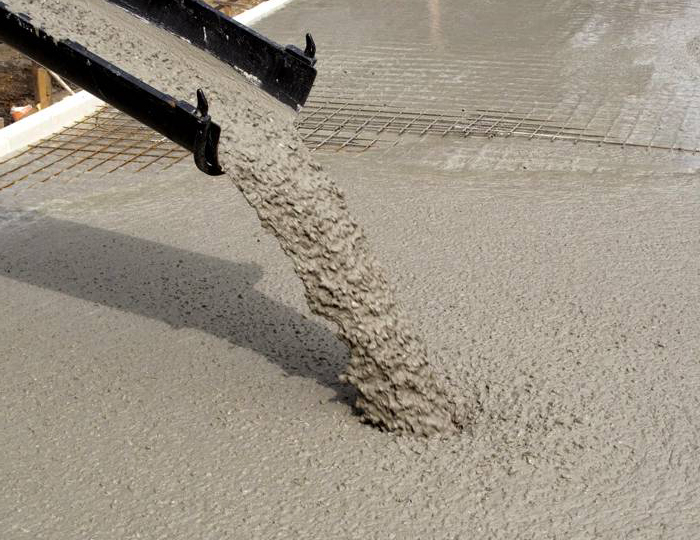
Soil incidents during the pouring (concreting) of the foundation of a private house
Perhaps the worst thing that can happen and cancel out all the work on pouring the foundation is the collapse of the foundation pit. Moreover, according to the law of meanness, this happens at the moment when the schedule is drawn up, and the first concrete mixer has already arrived and the concrete is being unloaded. In fact, there is no law of meanness - there is non-observance of the elementary rules of TU and SNiP.
Firstly, the pit must settle, and with a high level of groundwater, or with a possible increase in the period of early spring, an artificial drainage system must be installed along the perimeter. But it is best to plan to pull out the pit in the fall, and pour the foundation with concrete so that it is done in late spring, when the water from the seasonal precipitation leaves the soil. Then the walls of the trench / foundation pit will dry out and naturally strengthen, without the use of additional artificial measures, such as silicatization, cementation or bitumenization, which, moreover, poison the soil.

Secondly, the permissible height of unloading (falling) of concrete should be no more than two meters. If the pit itself is very deep, then use the additional extension chutes, which are contained in the inventory of the concrete mixer. In some cases, they additionally order a concrete pump, in some they build a special sleeve with a gutter with their own hands. It is worth noting that the greatest probability of crumbling of the trench / foundation pit is at the moment of unloading the concrete, since, in addition to the fact that the machine is in close proximity to the edge, strong vibrations from the fall of the mixture also appear. The worst outcome is that a concrete mixer truck will fail along with a team of concrete workers.
It is also worth paying attention to the composition of the soil even at the stage of excavation development, for example, in the case of dusty and sandy liquefying soils, landslide-prone and other areas, a special approach is needed, which is best described in the article "Types and arrangement of foundations for problematic areas and soils ". It says that in such cases, pile foundations are performed with additional measures for artificial soil strengthening.
Using PNSV wire: two common mistakes
The use of PNSV-wire is another common option for heating the concrete mass. When using this method, builders often make two main mistakes:
Lack of control of the connection of heating elements and ignoring the need to check the integrity of the wires used. In such a situation, the heating element is often turned off due to a broken or damaged wire, and a certain volume of concrete remains unheated. This leads to a violation of the temperature regime, as a result of which part of the structure freezes and cracks appear due to the lack of concrete of the required level of strength.
Incorrect laying of wires and insulating materials. Wires with "extra" length lead to an increase in power consumption and a decrease in the linear load on the wire, which, in turn, leads to an increase in the period of concrete heating.
The use of a heating wire also has several disadvantages:
- high labor intensity of the wire laying process;
- the need for complex calculations;
- large structures require large amounts of electricity to heat up.
Minus temperature and foundation arrangement
It is pointless to argue with weather phenomena, you need to correctly adapt to them. Therefore, the idea arose of developing methods for constructing reinforced concrete foundations in our difficult climatic conditions, which are possible for implementation in the cold period.
Note that their use will increase the construction budget, therefore, in most situations, it is recommended to resort to more rational options for constructing foundations. For example, use the bored method or carry out construction from factory-made foam concrete blocks.
At the disposal of those who are not satisfied with alternative methods, there are several proven methods of good practice. Their purpose is to bring concrete to a state of critical strength before freezing.
By the type of impact, they can be conditionally divided into three groups:
- Providing external care for the concrete mass poured into the formwork until the critical strength stage.
- Increase in temperature inside the concrete mass until sufficient hardening. It is carried out by means of electric heating.
- Introduction of modifiers into the concrete solution that lower the freezing point of water or activate processes.
The choice of the method of winter concreting is influenced by an impressive number of factors, such as the power sources available on the site, the forecast of weather forecasters for the hardening period, the ability to bring a heated solution. Based on local specifics, the best option is selected. The most economical of the listed positions is the third, i.e. pouring concrete at sub-zero temperatures without heating, which predetermines the introduction of modifiers into the composition.
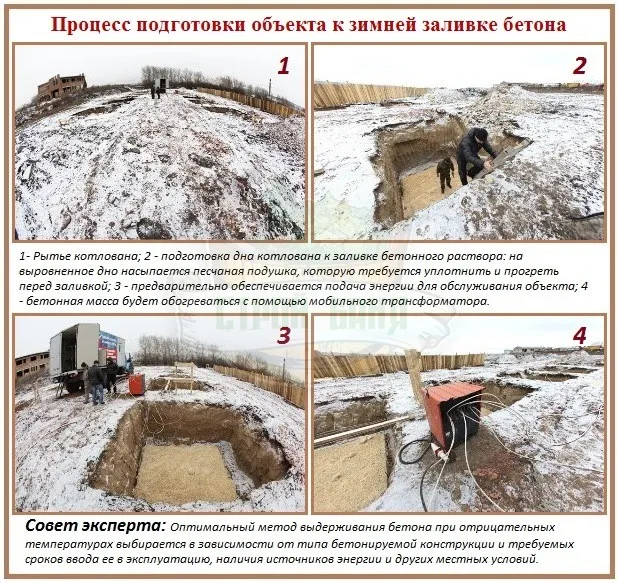
Possible consequences of winter concreting
Failure to comply with concrete placement technologies in winter leads to the production of concrete products of reduced strength, with cracks, efflorescence and other defects, as well as to poor adhesion to reinforcement. The products are short-lived in operation.
Concrete work in winter is most often a necessary measure, but in this case there are advantages. When choosing a technology for carrying out winter work, many factors are taken into account: the type of structures, the composition of the concrete mixture, the availability of equipment and the economic effect of their use. Antifreeze additives are desirable for use when choosing any method of conducting concrete work in winter.
Typical mistakes
Electrode heating of concrete
Electrode heating of the mixture is often accompanied by the following errors:
Mistake # 1. The electrodes have a low contact area with concrete, which is due to their design features. As a result, the heating becomes of poor quality. Air bubbles can also appear between the electrodes and the mixture. They cause the water to boil, blocking the spread of heat energy through the concrete. It concentrates in one place, forming cavities.
Mistake # 2. There is a reinforcing metal "skeleton" inside the concrete. If the electrode touches it during immersion, it instantly leads to a short circuit. Thus, expensive equipment fails, which may not be repairable. If there is nothing else to heat, then the mixture hardening technology is disrupted.
Mistake number 3. Increasing the current density in the immediate place of contact between concrete and electrodes. This is fraught with a slowdown in the rate of hydration, local overheating and the formation of a porous structure. It is noteworthy, but outwardly it is impossible to detect the mistake made. You can learn about it in the future, when the structure begins to collapse ahead of time.
Heating of concrete with a heating cable
Errors also occur when heating concrete with a heating cable:
Mistake # 1
Few builders pay attention to the connection diagram of heating elements. Especially if none of them have an education in electrical engineering
As for checking the integrity of the wires, this almost never happens at all. They are simply laid out on the surface. If the integrity is violated, then the heating cable cannot fulfill the role assigned to it. Or heating occurs only in certain places. Uneven heating leads to cracks and to rapid destruction of the internal structure of concrete.
Mistake # 2
When laying wires, pay attention to their insulation and correct positioning. Many people forget about it.
The cable should be of the optimal length - no more and no less than the intended one.Otherwise, its overrun is carried out, which leads to an increase in the duration of construction work.
The disadvantages of using a heating cable are as follows:
- Large capacities are required to heat up a significant volume of concrete. Often they are not present at the work site.
- It will take a lot of electrical calculations. This takes extra time and effort.
- An extremely limited number of specialists are able to properly lay the cable. Not all companies can afford to keep one on their staff.
These errors are the most common during concreting and heating by the listed methods. Knowing about them in detail, it is best to try to avoid them. After all, it is better to do everything right at once, rather than spend money on dismantling the old and installing a new structure in the future. Sometimes this requires the complete destruction of a building or object.
Hardening and concrete strength at low temperatures
 When the temperature of concrete drops below + 5C, its hardening and the increase in its strength slow down sharply, and at a temperature equal to the freezing temperature, it practically stops. At subzero temperatures, water in freshly laid concrete can freeze. At the same time, not only the hardening of concrete stops, but also under the influence of ice, the destruction of the weak structure of concrete can begin. After thawing and further hardening, such concrete will have a reduced strength, which is explained by the breaking of bonds between the granular filler and the cement stone by ice crystals.
When the temperature of concrete drops below + 5C, its hardening and the increase in its strength slow down sharply, and at a temperature equal to the freezing temperature, it practically stops. At subzero temperatures, water in freshly laid concrete can freeze. At the same time, not only the hardening of concrete stops, but also under the influence of ice, the destruction of the weak structure of concrete can begin. After thawing and further hardening, such concrete will have a reduced strength, which is explained by the breaking of bonds between the granular filler and the cement stone by ice crystals.
In order for fresh concrete to be resistant to freezing, a special composition of the concrete mixture is used and hardening is ensured at a positive temperature. Below are the data on the time required to achieve frost resistance (taking into account the norms of SNiP 3.03.01-87, tab. No. 6):

There are 3 ways to create favorable conditions for concrete hardening in winter at negative ambient temperatures:
- Concreting is carried out with a preheated concrete mixture, and then heat is retained in the concrete;
- Heating of formed concrete structures is used;
- Antifreeze chemical additives are used to prepare the concrete mixture.
Most often, winter concreting is carried out using a combination of the above measures.
Heating up the concrete mix
Station for heating concrete SPB-35 Duga
Produced during the preparation of concrete. The heating temperature is selected depending on the duration and method of transporting concrete to the place of laying and the ambient temperature
It is important that by the end of the formation of a monolithic concrete structure, the temperature in the concrete body does not drop below + 15C. After laying the concrete mixture, the structure is covered with a heat-insulating material so that the concrete hardens at a positive temperature. Concreting of massive monolithic structures is carried out taking into account the temperature released during the hydration of cement
To determine the exact temperature inside the hardening concrete, temperature sensors are placed in it.
Application of antifreeze additives
used to prevent freezing of concrete during transportation and laying of concrete mix. As antifreeze additives for the preparation of concrete are used:
- calcium chloride (CC);
- calcium nitrate (NC);
- a mixture of calcium nitrite and calcium nitrate (NOC);
- a mixture of nitrite, nitrate and calcium chloride (NHC);
- sodium chloride (CH);
- sodium nitrite (NH);
- sodium sulfate (CH);
- urea (urea);
- potash (P);
- sodium formate;
- technical pentaerythritol filtrate.
HC and CH are the most effective antifreeze additives. However, they can corrode the reinforcement and form efflorescence (white bloom) on the surface. Therefore, their use is strictly limited.Concrete mixtures with small dosages of NC and sodium formate included in their composition can be used at ambient temperatures down to -20C without fear of reinforcement corrosion and efflorescence on the concrete surface.
Antifreeze additives perform two functions at once: they accelerate the hardening of concrete and at the same time lower the freezing point of water. Water remains in liquid form, which allows concrete to harden even at temperatures below freezing.
.

